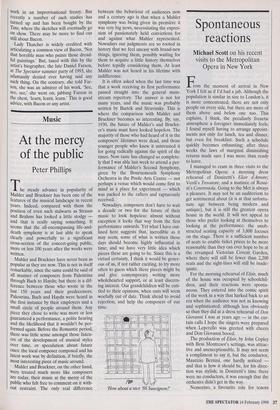Music
At the mercy of the public
Peter Phillips
The steady advance in popularity of Mahler and Bruckner has been one of the features of the musical landscape in recent years. Indeed, compared with them the position of even such stalwarts as Strauss and Brahms has looked a little stodgy and that is really saying something. It seems that the all-encompassing life-and- death symphony is at last able to speak clearly and powerfully to a significant cross-section of the concert-going public, more or less 100 years after the works were written.
Mahler and Bruckner have never been as popular as they are now. This is not in itself remarkable, since the same could be said of all manner of composers from Palestrina through Bach to Haydn; but there is a dif- ference between those who wrote in the last 150 years and their predecessors. Palestrina, Bach and Haydn were heard in the first instance by their employers and a small circle of people around them. Any piece they chose to write was more or less guaranteed a performance, a polite hearing and the likelihood that it wouldn't be per- formed again. Before the Romantic period, there was little sense amongst those listen- ers of the development of musical styles over time, or speculation about future ones: the local composer composed and his latest work was by definition, if briefly, the most interesting piece of music around.
Mahler and Bruckner, on the other hand, were treated much more like composers are today, their music at the mercy of the public who felt free to comment on it with- out restraint. The only real difference between the behaviour of audiences now and a century ago is that when a Mahler symphony was being given its premiere it was very big news, necessitating the expres- sion of passionately held convictions for and against what Mahler represented. Nowadays our judgments are so rooted in history that we feel uneasy with brand-new things, ignoring them, possibly waiting for them to acquire a little history themselves before tepidly considering them. At least Mahler was not heard in his lifetime with indifference.
It is often asked when the last time was that a work receiving its first performance passed straight into the general main- stream repertory. The answer is not for many years, and the music was probably written by Bartok and Stravinsky. This is where the comparison with Mahler and Bruckner becomes so interesting. By, say, 1930, the future of Mahler's and Bruckn- er's music must have looked hopeless. The majority of those who had heard of it in the composers' lifetimes were dead, and those younger people who knew it mistrusted it for going radically against the spirit of the times. Now taste has changed so complete- ly that I was able last week to attend a per- formance of Mahler's Second Symphony, given by the Bournemouth Symphony Orchestra in the Poole Arts Centre — not perhaps a venue which would come first to mind as a place for experiment — which was packed to the rafters and rapturously received.
Nowadays, composers don't have to wait a decade or two for the future of their music to look hopeless: almost without exception it looks that way from the first performance onwards. Yet what I have out- lined here suggests that, incredible as it may seem, some of what is written these days should become highly influential in time; and we have very little idea which pieces these are going to be. Since this is a virtual certainty, I think it would be gener- ous of us, if not rather exciting, to try more often to guess which these pieces might be and give contemporary writing more wholehearted support, or at least discern- ing interest. Our grandchildren will be enti- tled to their opinions, when ours will seem woefully out of date. Think ahead to avoid rejection, and help the composers of our time.
How about a nice '88 Sauvignon?'

























































 Previous page
Previous page